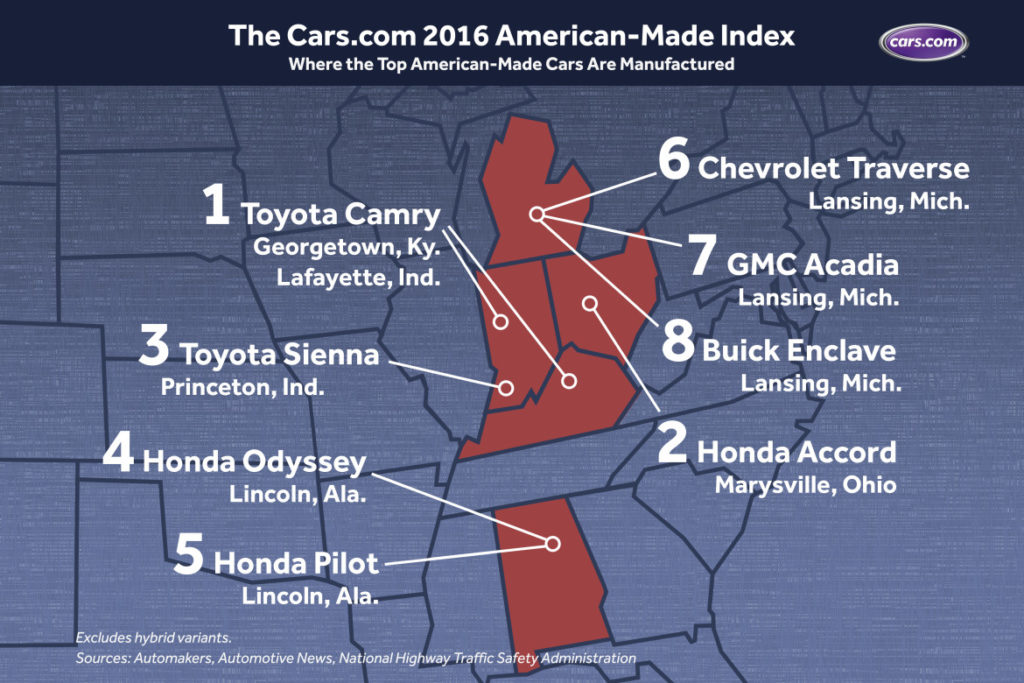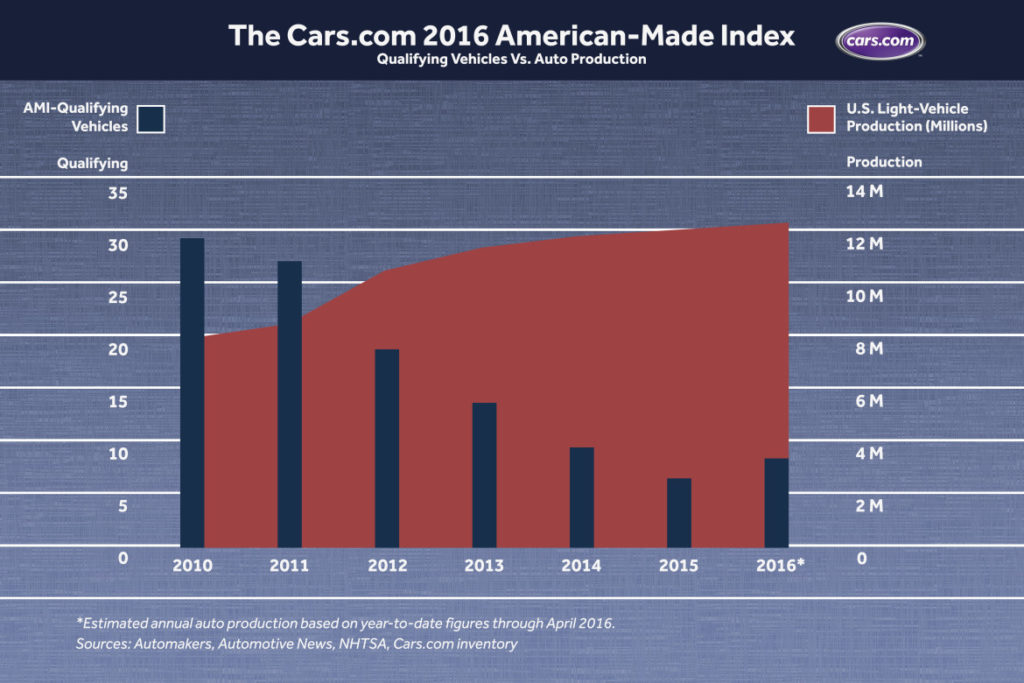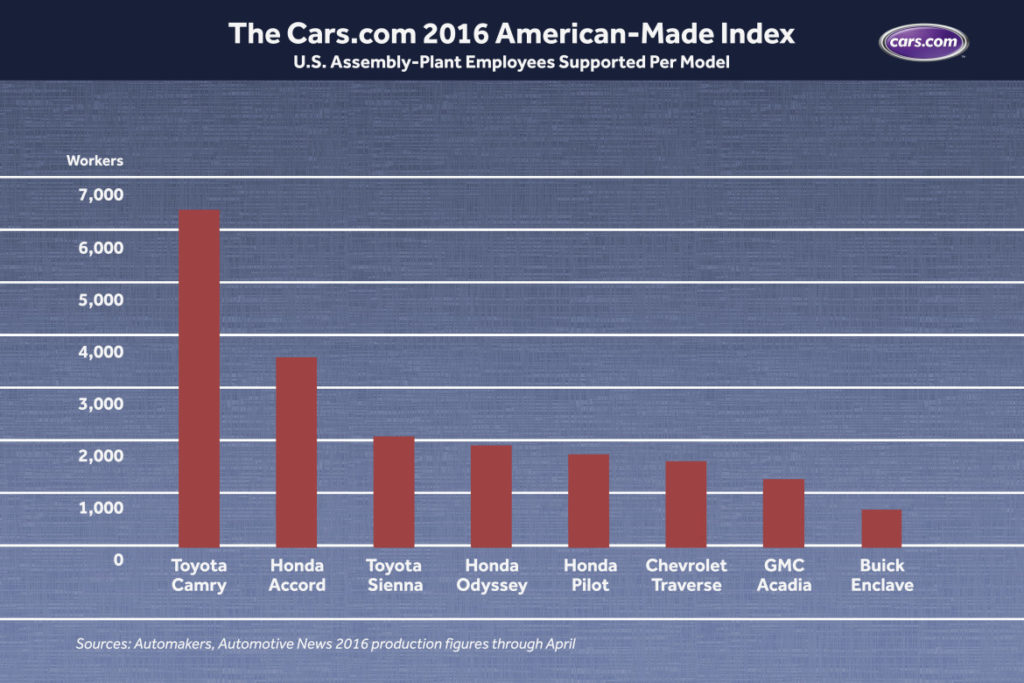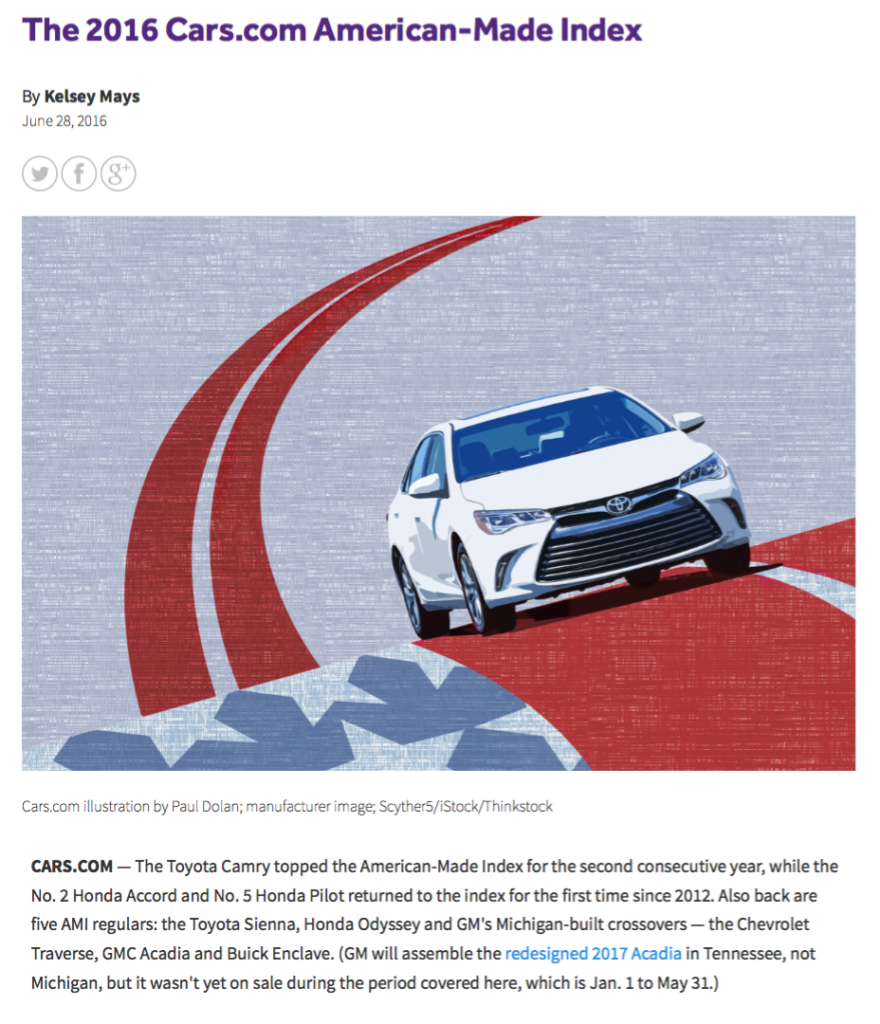Cars.com: The 2016 American-Made Index
Kelsey Mays
June 28, 2016
The Toyota Camry topped the American-Made Index for the second consecutive year, while the No. 2 Honda Accord and No. 5 Honda Pilot returned to the index for the first time since 2012. Also back are five AMI regulars: the Toyota Sienna, Honda Odyssey and GM’s Michigan-built crossovers — the Chevrolet Traverse, GMC Acadia and Buick Enclave. (GM will assemble the redesigned 2017 Acadia in Tennessee, not Michigan, but it wasn’t yet on sale during the period covered here, which is Jan. 1 to May 31.)

Source: Paul Dolan, Cars.com
1. Toyota Camry
2. Honda Accord
3. Toyota Sienna
4. Honda Odyssey
5. Honda Pilot
6. Chevrolet Traverse
7. GMC Acadia
8. Buick Enclave
After reaching an all-time low of just seven cars in 2015, the AMI is up to eight cars. That’s still lower than earlier AMIs, when the index regularly hit its 10-car limit, with dozens of models qualifying as recently as 2011.
In a testament to the auto industry’s globalization, that list of AMI-eligible cars has dwindled in recent years even as total U.S. light-vehicle production has increased.

Source: Paul Dolan, Cars.com
In today’s global economy, there’s no easy way to determine just how American a car is. Cars.com’s American-Made Index looks at cars on a model-by-model basis, not by manufacturer. It recognizes cars that are assembled here, using a high percentage of domestic parts, and which are bought in large numbers by American consumers.
Five of this year’s eight AMI cars are from foreign-based automakers; the last time a Detroit Three vehicle topped the AMI was in 2014, when the Ford F-150 pickup truck ranked No. 1. (This year’s F-150, like many other vehicles, fell below the AMI’s 75-percent eligibility threshold for domestic-parts content.) But in a year when auto manufacturing has been the subject of controversy on the presidential campaign trail, it’s important to remember the AMI rates cars, not automakers.
When it comes to the latter, the Detroit Three’s economic impact in the U.S. is undeniable. The American Automotive Policy Council, a group that represents GM, Ford and Fiat Chrysler Automobiles, claims its members employ more than two-thirds of all U.S. auto workers. The Detroit Three run 25 of the 42 U.S. assembly plants that build light-duty passenger cars bought in the U.S., according to Automotive News. The remaining 17 assembly plants come from nine other automakers: BMW, Honda, Hyundai-Kia, Mercedes-Benz, Nissan, Subaru, Tesla, Toyota and Volkswagen. All but Tesla are headquartered overseas.
But foreign-based automakers contribute plenty. A 2015 study by the Center for Automotive Research, a Michigan-based nonprofit group, found the auto industry accounts for about 3 percent of all foreign direct investment in the U.S. — some $74 billion in total. In its December 2015 contributions report, the Japan Automobile Manufacturers Association said U.S. vehicle production from Japan-based automakers has climbed from 2.3 million cars in 1995 to more than 3.8 million in 2014. Production drives employment. Cars.com analyzed employment and production figures to see how many assembly-plant jobs each model supports; it’s the same analysis we did in last year’s AMI. The 2016 analysis shows one foreign-based automaker’s car — the Toyota Camry — still supports the most assembly-plant jobs of any AMI vehicle by a wide margin.

Source: Paul Dolan, Cars.com
Of course, this doesn’t illustrate the full effect of each car. Automakers directly employ 322,000 American residents, CAR’s 2015 study found. But another 521,000 are employed building parts for those cars, while car dealerships employ another 710,000 American residents to sell and service those cars. In short, a given car doesn’t just drive certain direct employment at the assembly plant; it also spurs plenty of jobs at suppliers, dealerships and more.
The Camry isn’t the top car if you take an alternative approach to the AMI. For several years, we’ve also published what the results would be if the AMI used production numbers instead of sales figures as a barometer of assembly-line employment.
That puts the Honda Accord, not the Toyota Camry, up top.
2016 Production-Based Index (2016 AMI Rank)
1. Honda Accord (2)
2. Toyota Camry (1)
3. Toyota Sienna (3)
4. Honda Odyssey (4)
5. Honda Pilot (5)
6. Chevrolet Traverse (6)
7. GMC Acadia (7)
8. Buick Enclave (8)
Sources: Automakers, Automotive News, NHTSA
Despite the heightened political dialogue, or perhaps because more time has passed since the GM and Chrysler bailouts, fewer consumers care about purchasing from an American manufacturer. In a Cars.com survey of 892 respondents, 13 percent said they would only consider an American manufacturer when shopping for a car. That’s far less than a year ago, when 28 percent of respondents answered the same way.
Still, perceptions trail reality. The vast majority of respondents said models like the Chevrolet Corvette, Ford F-150 and GMC Acadia — all past or current AMI cars — are American-made, but less than half said the same of the Toyota Camry and Honda Accord. And less than a third of respondents said the Toyota Sienna, Honda Odyssey and Honda Pilot are American-made.
Creating This List
Cars.com’s American-Made Index rates vehicles built and bought in the U.S. Factors include the percentage of parts considered domestic under federal regulations, whether the car is assembled in the U.S. and U.S. sales. We disqualify models with a domestic-parts content rating below 75 percent, models built exclusively outside the U.S. or models soon to be discontinued without a U.S.-built successor.
Domestic-parts content stems from Congress’ 1992 American Automobile Labeling Act, which groups the U.S. and Canada under the same “domestic” umbrella. It’s one of the bill’s imperfections, but the AALA is the only domestic-parts labeling system car shoppers can find on every new car sold in America. Other domestic-content ratings — namely those used for the North American Free Trade Agreement and the corporate average fuel economy programs — are unpublished, give a simple over/under indication or lump even more countries, like Mexico, into the “domestic” pool.
Source: Cars.com
Click for PDF


